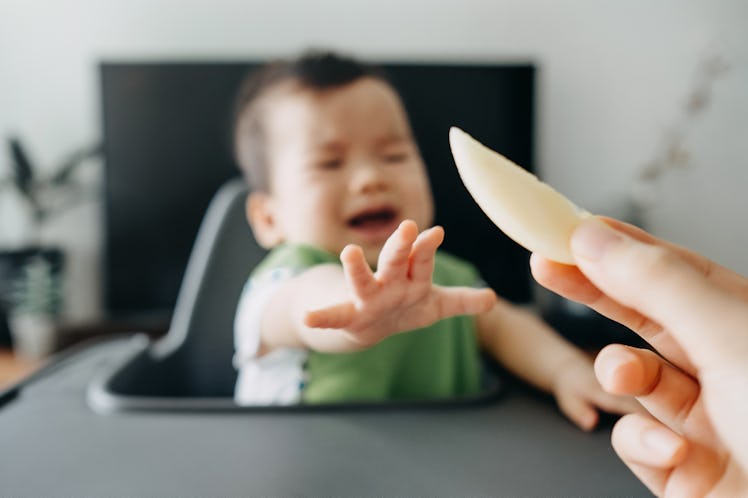The Pincer Grasp Is A Developmental Milestone Too Many Parents Ignore
Putting thumb to forefinger is just as amazing as walking.

Parents proudly celebrate when their baby rolls over, crawls, toddles, talks, and walks, but there aren’t many social media posts boasting of a baby’s pincer grasp development. That’s odd considering that the pincer grasp (which kids typically develop between 9 and 10 months old) is probably one of the more useful developmental milestones a kid can acquire. With it, they can pick up finger foods, color with more finesse and detail, and eventually tie their shoes. Walking is fun, sure, but so is the ability to add a pinch of paprika to your paprikash.
What Is the Pincer Grasp?
Unlike gross motor skills that focus on the movement of the limbs, the pincer grasp is a fine motor skill requiring the movement of just two fingers. But even though the movements aren’t big, grasping an object between the thumb and pointer finger requires a lot of coordination between muscles and the nervous system.
Consider what it takes to pick a piece of lint from a pair of pants. First, the eyes recognize the lint. Then, the brain coordinates the arm with the visual input to move the hand into position. Once in position, the small muscles in the hand work together, bringing the thumb and forefinger together. Then, mechanoreceptors in the fingers tell the brain how much pressure to apply to keep from crushing the object. Finally, with just the right amount of force, the lint is plucked and lifted away.
“Babies use the pincer grasp to pick up food, or things that aren’t food that they treat like food,” explains Celeste Kidd, Ph.D., a child development researcher at the University of California Berkeley. “It’s also important for other kinds of fine motor tasks, like buttoning your own shirt or doing a zipper on your own coat.”
At What Age Do Babies Develop the Pincer Grasp?
Considering all the sophisticated systems that need to be in place, the pincer grasp is not an early developmental milestone. By 2 months, typical babies will have enough hand-eye coordination and limb control to bring an object to their mouth. But the ability to reach and grasp will generally require that a baby can sit up without falling over, a skill that develops around 6 months. Once a kid is stable enough to reach out, they’ll slowly hone the pincer ability, first manipulating large objects with a full hand grasp and slowly working toward manipulating smaller objects. For most babies, the pincer grasp will be pretty well developed around 10 months of age.
That said, there is a huge variation between babies in terms of when they develop certain skills. Children develop at their own pace, and coming early or late to a skill does not suggest a child will have poor outcomes in life.
“If a parent is concerned about their child’s apparent failure to develop a skill, they should know that there’s variation in terms of when kids develop,” Kidd says. “But you’re never going to do harm to a kid by checking in with a pediatrician.”
How Do Babies Learn the Pincer Grasp?
Most babies will work out the pincer grasp on their own if they’re exposed to objects that are small and interesting enough to want to pick up. A table littered with Cheerios is a fine incentive, but so too are strings and sticks and pebbles.
There are plenty of toys and objects that will encourage a kid to use their pincer grasp. But parents shouldn’t sweat pushing any kind of development. “Being neurotic about it to the point of misery for you and your child is not good,” Kidd says. “When the activity is fun for you and your kid to do, then that’s a good activity. If your kid doesn’t want to do your activity, do something else.”
This article was originally published on